Microscopes Study guides, Class notes & Summaries
Looking for the best study guides, study notes and summaries about Microscopes? On this page you'll find 1168 study documents about Microscopes.
Page 4 out of 1.168 results
Sort by
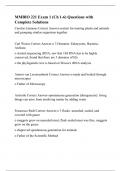
-
MMBIO 221 Exam 1 (Ch 1-6) Questions with Complete Solutions
- Exam (elaborations) • 32 pages • 2024
-
- $15.49
- + learn more
Carolus Linnaeus Correct Answer-system for naming plants and animals and grouping similar organisms together Carl Woese Correct Answer-o 3 Domains: Eukaryotes, Bacteria, Archaea o started sequencing rRNA, saw that 16S RNA has to be highly conserved, found that there are 3 domains of life o the phylogenetic tree is based on Woese's rRNA analysis Antoni van Leeuwenhoek Correct Answer-o made and looked through microscopes o Father of Microscopy Aristotle Correct Answer-spontaneous gene...
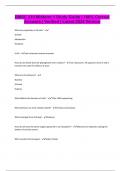
-
BMSC 210 Midterm 1 Study Guide | 100% Correct Answers | Verified | Latest 2024 Version
- Exam (elaborations) • 30 pages • 2024
- Available in package deal
-
- $13.49
- + learn more
What are properties of all cells? - Growth Metabolism Evolution LUCA - Last universal common ancestor How do we decide how the phylogenetic tree is drawn? - Use ribosomes. All organisms have it and it has been the same for billions of years What are the domains? - Bacteria Archaea Eukarya What defines the domains of cells? - Their rRNA sequencing What domains are most closely related? - Archaea and eukarya What emerged from Archaea? - Eukarya How do we know kw when oxygen appeare...
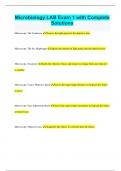
-
Microbiology LAB Exam 1 with Complete Solutions
- Exam (elaborations) • 22 pages • 2024
- Available in package deal
-
- $9.99
- + learn more
Microbiology LAB Exam 1 with Complete Solutions Microscope- The Condenser focuses the light ging into the objective lens Microscope- The Iris Diaphragm adjusts the amount of light going into the objective lens Microscope- Nosepiece holds the objective lenses and rotates to change from one objective to another Microscope- Coarse Objective Knob moves the stage larger distances to help get the object in focus Microscope- Fine Adjustment Knob moves the stage smaler increments to help get the obj...
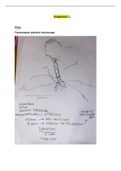
-
BTEC applied science - unit 17 assignment 1: learning aim A & B
- Other • 29 pages • 2022
- Available in package deal
-
- $16.86
- 4x sold
- + learn more
Achieve a MERIT- DISTINCTION using this assignment. It includes all of the classification for each micro-organism from kingdom down to species with an explained detailed paragraph explaining why each is in the classification. I have also included pictures of the drawing and all of the calculations of actual sizes. The calculation of actual size and diagram for the stereo microscope will be completely different to you depending on which cell you will be looking at under the microscope. The diffe...
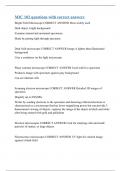
-
MIC 102 questions with correct answers
- Exam (elaborations) • 23 pages • 2023
- Available in package deal
-
- $21.49
- + learn more
Bright Field Microscope CORRECT ANSWER Most widely used Dark object, bright background Examine stained and unstained specimens Made by putting light through specimen Dark field microscope CORRECT ANSWER Image is lighter than illuminated background Uses a condenser on the light microscope Phase contrast microscope CORRECT ANSWER Used with live specimen Produces image with specimen against gray background Can see internal cells Scanning electron microscope CORRECT ANSWER Detailed 3D...

-
A LEVEL BIOLOGY PAPER 1 EXAM Exam | Questions & 100% Correct Answers (Verified) | Latest Update | Grade A+
- Exam (elaborations) • 17 pages • 2024
-
- $13.49
- + learn more
Q1 >>> Which of the following statements, A to D, about differential staining is not true? A - Differential staining can distinguish between different organelles. B - Differential staining can distinguish between types of cell. C - Differential staining can distinguish between types of organism. D - Differential staining is a common feature of electron microscopy : *D* Electron microscopes produce black and white images, so stains will not show up A is true - e.g. methylene ...
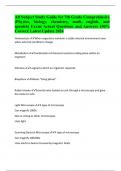
-
All Subject Study Guide for 7th Grade Comprehinsive (Physics, biology, chemistry, math, english, and spanish) Exam| Actual Questions and Answers 100% Correct| Latest Update 2024
- Exam (elaborations) • 49 pages • 2024
-
- $12.49
- + learn more
Homeostasis When organisms maintain a stable internal environment even when external conditions change Metabolism Combination of chemical reactions taking place within an organism Stimulus A signal to which an organism responds Biosphere Means "living planet" Robert Hooke Scientist who looked at cork through a microscope and gave the name to cells Light Microscope A type of microscope Can magnify 1000x Not as strong as other microscopes Uses light Scanning Electron Microscope A typ...
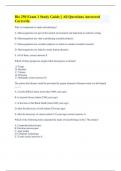
-
Bio 250 Exam 1 Study Guide || All Questions Answered Correctly.
- Exam (elaborations) • 21 pages • 2024
- Available in package deal
-
- $12.99
- + learn more
Why is it important to study microbiology? A. Microorganisms are part of the natural environment and important to nutrient cycling. B. Microorganisms are vital to producing essential products. C. Microorganisms are excellent subjects on which to conduct scientific research. D. Microorganisms are linked to many human diseases. E. All of these. correct answers E Which of these groups are single-celled and possess a nucleus? A. Fungi B. Bacteria C. Viruses D. Protozoa ...

-
BIOL 1073 Microbiology for Nursing Week 1 - Course overview, policy review & introduction to Microbiology in Health & Disease. Microbiology is the study of very small living organisms. Often known as microorganisms, microbes or pathogens. Even before m
- Exam (elaborations) • 28 pages • 2024
- Available in package deal
-
- $12.99
- + learn more
BIOL 1073 Microbiology for Nursing Week 1 - Course overview, policy review & introduction to Microbiology in Health & Disease. Microbiology is the study of very small living organisms. Often known as microorganisms, microbes or pathogens. Even before microscopes were invented, microorganisms still existed in this world, such as the black plague that caused 3 pandemics.
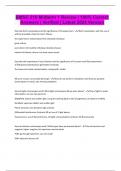
-
BMSC 210 Midterm 1 Review | 100% Correct Answers | Verified | Latest 2024 Version
- Exam (elaborations) • 11 pages • 2024
- Available in package deal
-
- $10.49
- + learn more
Describe Koch's postulates and the significance of his experiment - Koch's postulates: with the use of anthrax provided a basis for Germ Theory. the experiment: extract blood from diseased individual grow culture put culture into healthy individual, develop disease extract this blood, culture it to show same results Describe the importance of Louis Pasteur and the significance of his swan-neck flask experiment - Disproved spontaneous generation (miasma) the swan-neck made contamination...

How much did you already spend on Stuvia? Imagine there are plenty more of you out there paying for study notes, but this time YOU are the seller. Ka-ching! Discover all about earning on Stuvia


